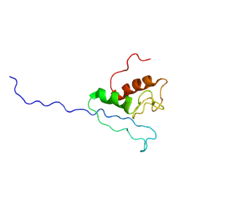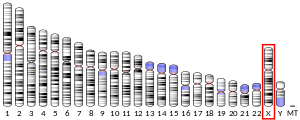ZIC3
ZIC3 is a member of the Zinc finger of the cerebellum (ZIC) protein family.[5][6]
ZIC3 is classified as a ZIC protein due to conservation of the five C2H2 zinc fingers, which enables the protein to interact with DNA and proteins. Correct function of this protein family in critical for early development, and as such mutations of the genes encoding these proteins is known to result in various congenital defects. For example, mutation of ZIC3 is associated with heterotaxy,[7] that is thought to occur due to the role of ZIC3 in initial left-right symmetry formation, which involves the maintaining redistributed Nodal after the asymmetry of the embryo is initially broken.[8] Mutation of ZIC3 is also associated with various heart defects, such as heart looping, however these are thought to represent a mild form of heterotaxy. Mouse based studies have linked defective ZIC3 with neural tube defects (spina bifida) and skeletal defects.[9]
ZIC3 is also of particular interest as it has been shown to be required for maintenance of embryonic stem cell pluripotency.[10]
Involvement in Wnt signalling
ZIC2, another member of the ZIC family, has recently been found to interact with TCF7L2, enabling it to act as a Wnt/β-catenin signalling inhibitor.[11] Further experiments have indicated that human ZIC3 is also able to inhibit Wnt signalling and that the Zinc finger domains are absolutely critical for this role.[12] Such a role is of critical importance, as not only is correct Wnt signalling critical for early development,[13] Wnt signalling has also been found to be upregulated to several cancers.
References
- GRCh38: Ensembl release 89: ENSG00000156925 - Ensembl, May 2017
- GRCm38: Ensembl release 89: ENSMUSG00000067860 - Ensembl, May 2017
- "Human PubMed Reference:". National Center for Biotechnology Information, U.S. National Library of Medicine.
- "Mouse PubMed Reference:". National Center for Biotechnology Information, U.S. National Library of Medicine.
- Ali RG, Bellchambers HM, Arkell RM (November 2012). "Zinc finger of the cerebellum (Zic): Transcription factors and co-factors". Int J Biochem Cell Biol. 44 (11): 2065–8. doi:10.1016/j.biocel.2012.08.012. PMID 22964024.
- "Entrez Gene: ZIC3 Zic family member 3 heterotaxy 1 (odd-paired homolog, Drosophila)".
- Ware SM, Peng J, Zhu L, Fernbach S, Colicos S, Casey B, Towbin J, Belmont JW (January 2004). "Identification and functional analysis of ZIC3 mutations in heterotaxy and related congenital heart defects". Am J Hum Genet. 74 (1): 93–105. doi:10.1086/380998. PMC 1181916. PMID 14681828.
- Ware SM, Harutyunyan KG, Belmont JW (January 2006). "Heart defects in X-linked heterotaxy: evidence for a genetic interaction of Zic3 with the nodal signaling pathway". Dev. Dyn. 235 (6): 1631–7. doi:10.1002/dvdy.20719. PMID 16496285.
- Purandare SM, Ware SM, Kwan KM, Gebbia M, Bassi MT, Deng JM, Vogel H, Behringer RR, Belmont JW, Casey B (May 2002). "A complex syndrome of left-right axis, central nervous system and axial skeleton defects in Zic3 mutant mice". Development. 129 (9): 2293–302. PMID 11959836.
- Lim LS, Hong FH, Kunarso G, Stanton LW (November 2010). "The pluripotency regulator Zic3 is a direct activator of the Nanog promoter in ESCs". Stem Cells. 28 (11): 1961–9. doi:10.1002/stem.527. PMID 20872845.
- Pourebrahim R, Houtmeyers R, Ghogomu S, Janssens S, Thelie A, Tran HT, Langenberg T, Vleminckx K, Bellefroid E, Cassiman JJ, Tejpar S (October 2011). "Transcription factor Zic2 inhibits Wnt/β-catenin protein signaling". J Biol Chem. 286 (43): 37732–40. doi:10.1074/jbc.M111.242826. PMC 3199516. PMID 21908606.
- Ahmed JN, Ali RG, Warr N, Wilson HM, Bellchambers HM, Barratt KS, Thompson AJ, Arkell RM (May 2013). "A murine Zic3 transcript with a premature termination codon evades nonsense-mediated decay during axis formation". Dis. Models Mech. 6 (3): 755–67. doi:10.1242/dmm.011668. PMC 3634658. PMID 23471918.
- Fossat N, Jones V, Khoo PL, Bogani D, Hardy A, Steiner K, Mukhopadhyay M, Westphal H, Nolan PM, Arkell R, Tam PP (February 2011). "Stringent requirement of a proper level of canonical WNT signalling activity for head formation in mouse embryo". Development. 138 (4): 667–76. doi:10.1242/dev.052803. PMID 21228006.
Further reading
- Bellchambers HM, Ware SM (2018). "ZIC3 in Heterotaxy". Advances in Experimental Medicine and Biology. 1046: 301–327. doi:10.1007/978-981-10-7311-3_15. PMID 29442328.
- Houtmeyers R, Souopgui J, Tejpar S, Arkell R (2013). "The ZIC gene family encodes multi-functional proteins essential for patterning and morphogenesis". Cell Mol Life Sci. 70 (20): 3791–811. doi:10.1007/s00018-013-1285-5. PMID 23443491.
- Bedard JE, Purnell JD, Ware SM (2007). "Nuclear import and export signals are essential for proper cellular trafficking and function of ZIC3". Hum. Mol. Genet. 16 (2): 187–98. doi:10.1093/hmg/ddl461. PMID 17185387.
- Zhu L, Harutyunyan KG, Peng JL, et al. (2007). "Identification of a novel role of ZIC3 in regulating cardiac development". Hum. Mol. Genet. 16 (14): 1649–60. doi:10.1093/hmg/ddm106. PMID 17468179.





